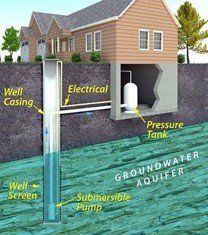Lead in Private Well Water and its Impacts on Children's Health
You might be surprised to learn that tens of millions of Americans rely on private wells for their drinking water. My grandfather's home in rural East Texas highlights a critical issue: The house, built over a century ago, likely contains lead components in its plumbing, specifically, pipes and fixtures that deliver water to the faucet. Lead exposure can largely go unnoticed until significant health issues arise, like hearing problems, slowed growth, anemia, among others. Water quality from private wells is not regulated by the EPA but may be regulated by state or local authorities.
As an intern in the Office of Children's Health Protection at the EPA, I have learned about the serious health risks that lead exposure poses to children. I am particularly concerned about how many families lack awareness about the importance of testing well water, now that I know its quality is not federally regulated.
Many people often assume that clear water is safe to drink. However, harmful contaminants may be present without visible signs. Lead can be present in drinking water without any noticeable changes in color or odor. It is the responsibility of private well owners to test their water for lead and to take appropriate measures to mitigate exposure. Understanding the risks associated with lead in drinking water is crucial, especially when considering its impact on children's health.
Lead's Health Impacts in Children
There is no safe level of lead. Lead exposure is harmful at any age, but it poses a greater risk to young children, infants, and fetuses.
The physical and behavioral effects of lead occur at lower exposure levels in children than in adults. A dose of lead that might have minimal effect on an adult can have significant consequences for a child. Lead poisoning can lead to both physical and behavioral issues, and these impacts can be long-lasting or even permanent. The health impacts of lead can vary significantly depending on the stage of life during which exposure occurs.
Children can be exposed to lead from various sources in addition to private wells, including contaminated water from old pipes, playing in contaminated soil, inhaling dust from deteriorating paint, consuming food stored in lead-glazed pottery, and playing with toys containing lead. This widespread exposure underscores the urgent need for vigilance and prevention efforts to protect children's health and development. Children are especially at risk because they frequently put their hands and objects in their mouths, which can transfer lead from contaminated surfaces directly into their bodies.
If you believe your child may have been exposed to lead, it is important to have them tested with a blood lead test at your pediatrician's office or local county health department. Lead poisoning often doesn't present visible symptoms, making testing important to the early identification of exposure.
Health impacts of lead on children include:
- Behavior and learning problems
- Lower IQ and hyperactivity
- Slowed growth
- Hearing problems
- Anemia
In rare cases, high ingestion of lead can cause seizures, coma, and even death.
The Important of Testing Your Water for Lead

Private well owners are responsible for delivering safe drinking water to their households. Testing is important because lead does not affect the taste, odor, or color of the water. The internal plumbing of a home may have old pipes, solders, and fixtures that are made with lead. Similarly, older homes may have well pumps or well casings with lead-containing parts. Naturally acidic or low-mineral content groundwater can corrode lead-containing materials and cause the lead to leach into the water.
Homeowners with private wells should test their drinking water more frequently if they have children, elderly family members, or someone pregnant or nursing living at home. The Centers for Disease Control and Prevention indicate that pregnant mothers can expose their fetus to lead through blood and breastfeeding mothers can expose their infants through breastmilk. For more recommendations on testing your water, visit EPA's private wells website.
EPA's Role in Lead in Drinking Water
Under the Safe Drinking Water Act (SDWA), the EPA is responsible for setting and enforcing standards for safe lead levels in public water systems. The EPA assigned a Maximum Contaminant Level goal (MCLG) of zero for lead in drinking water due to its toxicity even at low levels. EPA has set required treatment techniques (referred to as the Lead and Copper Rule) that regulate corrosivity of water because lead contamination is often due to corrosive water and its contact with lead pipes. The recent Lead and Copper Rule Improvement requires the replacement of lead pipes within ten years and more rigorous testing of drinking water. In private wells, these techniques are not required. EPA estimates that over 23 million households across the United States rely on private well water for drinking.
There is no requirement for monitoring lead or other contaminants in private water wells, as they are not federally regulated, and most states have limited regulations on private drinking water wells. Accordingly, it is important that households with private wells regularly test the quality of their drinking water.
What You Can Do to Mitigate Lead in Your Water

EPA has a quick check for lead guide that can help determine if you have lead plumbing. All you need is a penny (or key) and a magnet. If you have a confirmed lead pipe, you should contact your water company or a licensed plumber for confirmation and replacement options.
If you determine you have a lead pipe:
- Use a water filter certified to remove lead.
- Flush your water on cold before drinking or cooking, especially if it hasn't been used for several hours. (In public water systems, the amount of flushing time necessary depends on if you have a lead service line and the length of the lead service line).
- Use only cold water for cooking and drinking.
- Clean your faucet's screen (aerator) regularly to remove any lead particles that may collect there.
- Learn about construction in your neighborhood that may disturb the line.
- Have your water tested regularly.
As we observe Children's Health Month throughout October, it is crucial to take proactive steps to ensure the safety of our drinking water. Testing your private well for lead is an essential measure to protect the health of children in your home. If left untested, lead contamination in private wells can remain undetected, posing serious health risks, particularly to young children.
I encourage you to initiate conversations with family and friends who rely on private wells, emphasizing the importance of regular testing for lead. Together, we can create a greater awareness and commitment to protecting children's health.

About the Author
Sara Eaves
Intern
Office of Children's Health Protection
Sara is currently completing her Master of Public Health with a concentration in Environmental Health Science and Policy at George Washington University in Washington, D.C. Her ultimate goal is to promote sustainable energy to reduce air pollution.
Editor’s Note: The views expressed here are intended to explain EPA policy. They do not change anyone’s rights or obligations. You may share this article. However, please do not change the title or the content, or remove EPA’s identity as the author. If you do make substantive changes, please do not attribute the edited title or content to EPA or the author.
EPA’s official web site is www.epa.gov. Some links on this page may redirect users from the EPA website to specific content on a non-EPA, third-party site. In doing so, EPA is directing you only to the specific content referenced at the time of publication, not to any other content that may appear on the same webpage or elsewhere on the third-party site, or be added at a later date.
EPA is providing this link for informational purposes only. EPA cannot attest to the accuracy of non-EPA information provided by any third-party sites or any other linked site. EPA does not endorse any non-government websites, companies, internet applications or any policies or information expressed therein.
